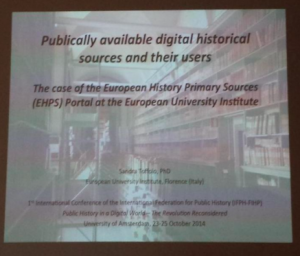Today at 9 AM one of the last lectures of the IFPH 2014 was in the Compagnietheater. The lecture ‘Public History and Access to Sources’ was presented by Sandra Toffolo (collaborator at the European University Institute Florence), Francesca Morselli (researcher at Collaborative European Digital Archive Infrastructure) and chairwoman Connie Schulz (Distinguished Professor Emeritus in Department of History of South Carolina).

They talked about different projects that collected and presented sources online. This is an important subject in a digital age were there is a seemingly unlimited and ever-growing amount of sources online. In some cases looking for particular sources is like looking for a needle in a haystack. Now, but even more for the future alternatives have to be developed to tackle thechaos of the countless digital sources. This is exactly the goal of both projects.
The first speaker was Sandra Toffolo. She spoke about her project European History Primary Sources (EHPS). As an initiative of the European University Institute she describes this as ‘searchable index of scholarly digital repositories that contain primary sources for the history of Europe from the Middle Ages to the present’. During this project she asked herself: What is the goal of the users and how they were using the website? Considering the keywords it became clear the also a lot of non- historians were using the website of various reasons.
Francesca Morselli spoke about similar projects of historical research in digital research infrastructure. She presented also on behave of Andrea Buchner was not able to speak today. First Morselli discussed CENDARI, that stands for Collaborative European Digital Archive. This contains resources of the First World War and Medieval European History. Within CENDARI there is project called Archival Research Guides (ARGs). That is not yet online. The aim of the ARGs is to provide the historians digital tools for ‘aggregation, interrogation and visualization of historical resources’. The overall aim is to balance the hidden collections and archives to the well-known archives and also shares resources between historians and non-historians.
Comparing these the projects of both speakers there are a lot of similarities. The women were therefore asked if they were actually not competing with on another. This was denied, but nonetheless there were resemblances: both work within a fixed timeframe to select and have seemingly the same goal in mind. The differences were that the project of Toffolo was depending more on descriptions of archives than Morselli. As Toffolo used already existing archives, to which the project directly links to, Morselli made the selections and collections herself with the help of users.
These carefully put together projects seem like the perfect answer to the problem of the big amount of (digital) sources. But that is unfortunately not entirely true. There is a danger in getting a lot of people involved in these projects. The more sources users collect, the more chaotic and harder it is to find the right sources for they not connect the right sources. This would bring them back to square one. Furthermore if the users are connecting the right sources who is there to tell which are reliable sources to include and which are not. A historian could probably tell, but an accountant that is interested in history probably not. These discussion at the end of the lecture touches the big questions in the field of public history: ‘How to deal with the big data in the digital world?’ and ‘Should non-professionals be involved in making public history?’
By Selma Hofstra